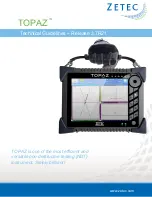
37
Exercise B - Generation of overland flow
Theory
Overland flow is the rainfall that fails to infiltrate the surface and subsequently travels
over the ground until it reaches channel flow, infiltrates or evaporates. It is rarely
seen, but may be important in a number of situations, for example where ground
conditions are saturated or frozen, or where the soil is highly compacted or very dry.
Overland flow generally forms part of the quickflow element of the runoff process,
and can vary considerably from catchment to catchment. The process of overland
flow has important hydrological consequences, as it acts as a strong influence on the
variation of streamflow with time in a catchment corresponding to a rainfall event.
Procedure
Connect the flexible piping from the overhead spray nozzles to the quick release
connector on the 3 l/min flow meter.
Set the sand tank to a slope of between 3.5% and 4.5%. Mould the sand into a
miniature drainage basin. This should include a central channel or valley leading to
the deep cut-out at the foot of the tank. Include areas where overland flow would be
expected to form, such as areas close to the water table and/or areas of flow
convergence. Keep the topography simple to allow a clear drainage system to
develop. Record the topography created, noting areas of high and low slope and
elevation.
Decide on the rainfall event to be simulated. The following options are all possible:
Prolonged low-intensity rainfall
Short high-intensity rainfall
Alternating intensity rainfall
Multiple rainfall events
Observations of the sediment bed should be made throughout the simulation, noting
the rainfall flow rate, outlet flow rate, and when and where the development of
overland flow was seen. The development of source areas should also be recorded
once overland flow has commenced. At the end of the rainfall event, observations
should continue until the simulator has drained for 30-45 minutes.
The experiment may be repeated with a variation in a single characteristic, such as
rainfall intensity or topography, to determine the effects of these controls.
Results
Description of catchment area and initial channel planform:
Sketch of catchment area:
Summary of Contents for S12-MKII
Page 1: ...Advanced Environmental Hydrology System Instruction Manual S12 MKII ISSUE 21 February 2014...
Page 4: ......
Page 8: ...4 Equipment Diagrams Figure 1 Front View of S12 MKII Hydrology System...
Page 9: ...Equipment Diagrams 5 Figure 2 Plan View of S12 MKII Hydrology System...
Page 10: ...Armfield Instruction Manual 6 Figure 3 End View of S12 MKII Hydrology System...
















































